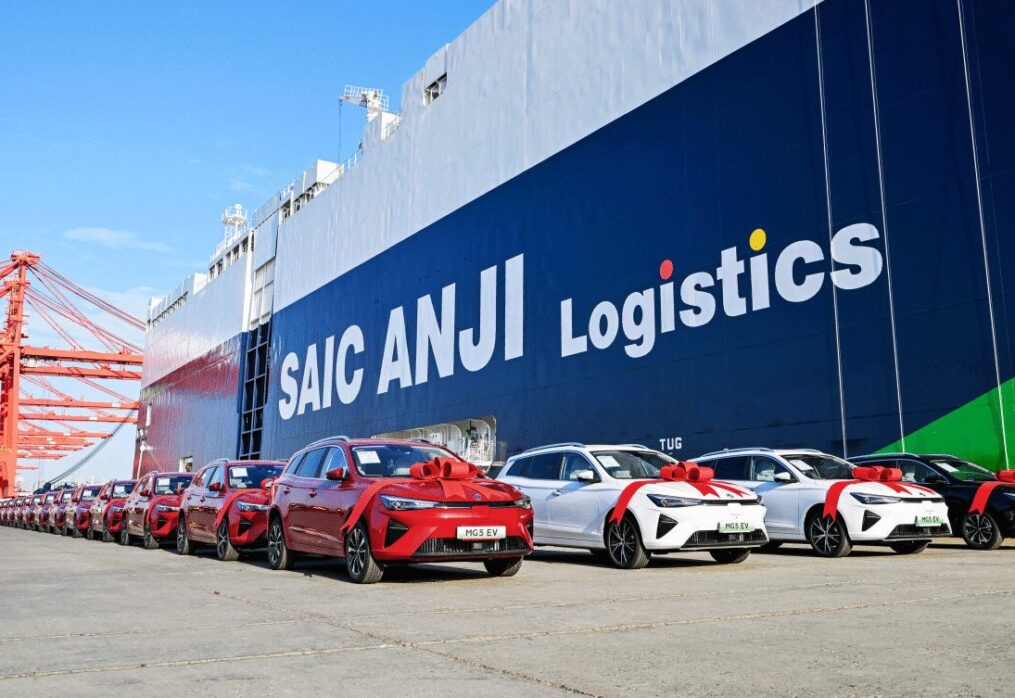China’s SAIC builds fossil LNG-powered ships for car exports as new EU climate policies kick in

China’s SAIC Motor Corp will spend $1.4 billion building 12 fossil liquefied natural gas (LNG)-powered ships to export cars, as Chinese electric vehicles spread overseas and the European Union tightens its climate and trading policies to reduce greenhouse gas emissions.
Why it matters: The move is the latest example of how EU regulations are pushing Chinese automakers to make changes to the way they operate, and adds to the challenges they face in expanding to overseas markets with their EVs.
Details: China’s biggest automaker said on Wednesday that the SAIC Anji Sincerity has begun its maiden trade voyage from Shanghai to Europe. The ship spans 200 meters (656 feet) in length and boasts capacity for 7,600 cars, making it the world’s largest ro-ro vehicle transport vessel partly powered by sustainable fuel.
- The container carrier is powered by both diesel and LNG, a form of natural gas that has been cooled to a liquid for easier storage and transportation, providing as much as a 30% reduction in carbon dioxide (CO2) emissions compared to similar-sized, diesel-only vessels, according to an announcement on China’s Twitter-like platform Weibo.
- SAIC expects to spend RMB 10 billion ($1.4 billion) on building 12 LNG carriers and lease two more for the next three years. The biggest of them will be able to carry as many as 9,000 cars, Zhao Aimin, vice president of SAIC Motor International, told financial media outlet Caixin (in Chinese).
- Volkswagen’s Chinese manufacturing partner expects its carriers to have a total combined capacity of 1.8 million cars per year by 2026. Its wholly-owned subsidiary Anji Logistics currently operates a fleet of 31 carriers on seven routes to Europe, Southeast Asia, and Latin America, and works with automakers Dongfeng and Great Wall Motor among others.
- Zhao also mentioned SAIC’s goal to sell 1.35 million cars overseas in 2024, which would mark a growth of more than 11% from the 1.2 million units it achieved last year. That number could be further increased to 1.5 million in 2025, with at least 14 new energy vehicles, including plug-in hybrids and all-electrics, set to go on sale globally over the next two years.
Context: SAIC is not the only Chinese carmaker to build its own fleet and set its sights on going global. Its move takes place as China recorded exports of 5.2 million cars last year, meaning a 57.4% annual growth rate, and is set to dethrone Japan to become the world’s largest car exporter.
- BYD’s first roll-on, roll-off, chartered vehicle carrier, named BYD Explorer No. 1, set sail towards Germany and the Netherlands from its base city of Shenzhen on Monday. Carrying more than 5,000 EVs, the vessel is reportedly managed by London-based Zodiac Maritime Ltd. and is being rented to BYD.
- The EU began mandating shipping companies, among other businesses, to buy CO2 permits for 40% of the CO2 generated by their fleets from January, a percentage that will grow to 70% and 100% over two years from 2025, Reuters reported.
- Meanwhile, the European Commission launched an anti-subsidy investigation of China-made EVs last October.
Jill Shen is Shanghai-based technology reporter. She covers Chinese mobility, autonomous vehicles, and electric cars. Connect with her via e-mail: jill.shen@technode.com or Twitter: @jill_shen_sh
More by Jill Shen

